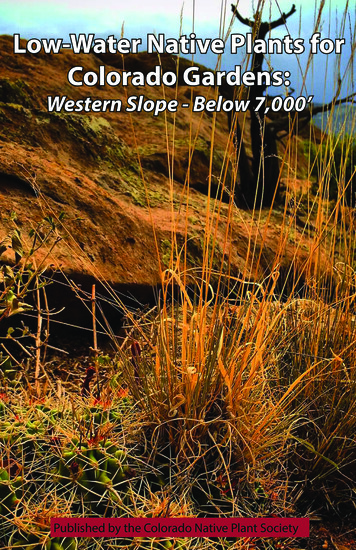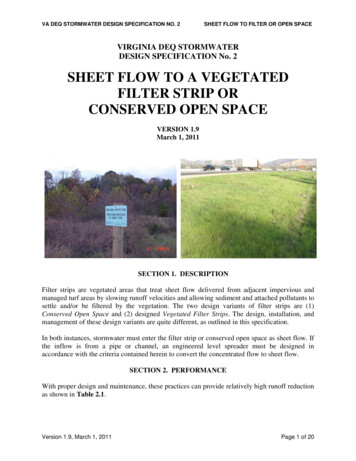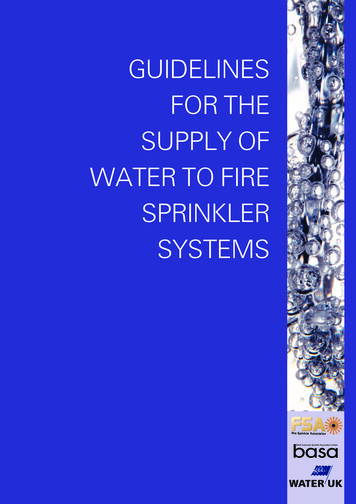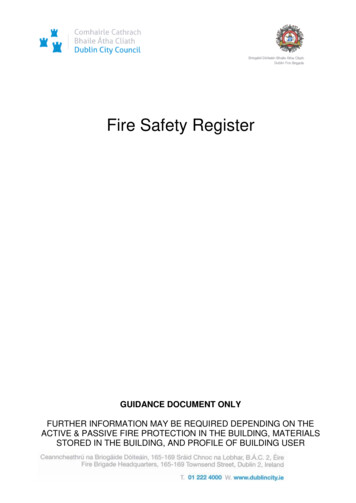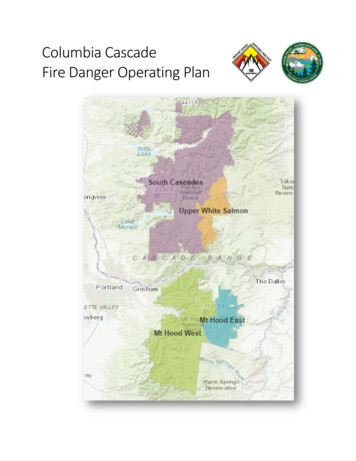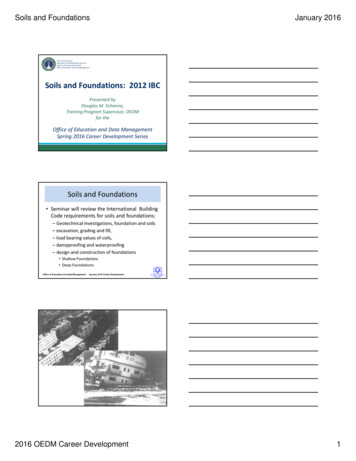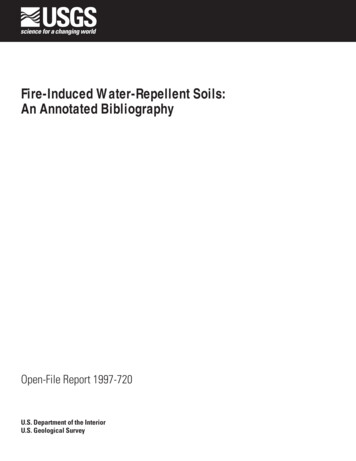
Transcription
Fire-Induced Water-Repellent Soils:An Annotated BibliographyOpen-File Report 1997-720U.S. Department of the InteriorU.S. Geological Survey
FIRE-INDUCED WATER-REPELLENT SOILS:AN ANNOTATED BIBLIOGRAPHYBy Mary A. Kalendovsky and Susan H. CannonU.S. GEOLOGICAL SURVEYOpen-File Report 97-720Golden, Colorado1997
FIRE-INDUCED WATER-REPELLENT SOILS: AN ANNOTATEDBIBLIOGRAPHYBy Mary A. Kalendovsky and Susan H. CannonABSTRACTThe development and nature of water-repellent, or hydrophobic, soils are important issues inevaluating hillslope response to fire. The following annotated bibliography was compiled toconsolidate existing published research on the topic. Emphasis was placed on the types,causes, effects and measurement techniques of water repellency, particularly with respect towildfires and prescribed burns. Each annotation includes a general summary of therespective publication, as well as highlights of interest to this focus. Although somereferences on the development of water repellency without fires, the chemistry ofhydrophobic substances, and remediation of water-repellent conditions are included,coverage of these topics is not intended to be comprehensive. To develop this database, theGeoRef, Agricola, and Water Resources Abstracts databases were searched for appropriatereferences, and the bibliographies of each reference were then reviewed for additionalentries.2
REFERENCESAdams, Susan, Strain, B.R., and Adams, M.S., 1970, Water-repellent soils, fire, andannual plant cover in a desert scrub community of southeastern California:Ecology, v. 51, p. 696-700.This was the first study to be conducted on fire-related water repellency in deserts.Researchers examined the vegetation mosaic that resulted from hydrophobic soils in a desertscrub community of Southern California, four years after fire. Large hummocks of soilsupported various shrubs, but were devoid of the annual plants that resided between thehummocks. Results of the study suggested that hydrophobic soil layers within thehummocks were responsible for the observed vegetation patterns. Fire appeared to intensifythe hydrophobic properties of the soil, and to increase the depth at which these layers werefound. Researchers also noted that the three different types of shrubs appeared to causevarying degrees of water repellency on their respective hummocks.Almendros, G., Gonzalez-Vila, F.J., and Martin, F., 1990, Fire-inducedtransformation of soil organic matter from an oak forest - an experimentalapproach to the effects of fire on humic substances: Soil Science, v. 149, no. 3,p. 158-168.This study describes the effects of fire on the organic matter from a Dystric Xerochreptunder oak forest. In laboratory experiments designed to simulate the effects of fire onisolated humic fractions, several physicochemical characteristics are described in the heatedsamples, as well as in humic substances extracted from samples of control and post fire soilareas. The study describes an irreversible dehydration and decarboxylation of the humuscolloids, which the authors suggest may play an important role in fire-induced waterrepellency. Although other authors have suggested that fire-induced translocation andfixation of hydrophobic compounds are responsible for the formation of water-repellentsoils, the results of this study suggest that the changes in surface properties of the humussubstances may also greatly increase the hydrophobicity of soils after burning. The thermalloss of the oxygen-containing functional groups turn the surface of the humusmacromolecules hydrophobic.Barrett, Gary, and Slaymaker, Olav, 1989, Identification, characterization, andhydrological implications of water repellency in mountain soils, SouthernBritish Columbia: Catena, v. 16, p. 477-489.This study evaluated and identified hydrophobic soils at various sites within the mountainsof British Columbia. Contrary to many other studies, these water-repellent soils were finegrained (one site was clay-silt lacustrine deposits). Researchers found that all sites in thesubalpine-alpine ecotone exhibited water-repellent or difficult-to-wet layers. These layers(no more than a few centimeters thick) occurred at or near the surface, and were found inlocations of accumulated organic matter. The results strongly indicated that the waterrepellency was associated with the accumulation of organic matter, specifically that derivedfrom vegetation in the alpine-subalpine ecotone. The authors noted that the repellencyappeared to be a “permanent” feature, in that it did not degrade with exposure to water.They also reported that water-repellent layers graded into gradually less repellent (or“transient”) layers below.3
Bashir, S.M., 1969, Hydrophobic soils on the east side of the Sierra Nevada: Reno,University of Nevada, M.S. thesis, 97 p.The occurrence of water repellency on the east side of the Sierra Nevada was evaluated withrespect to a variety of soil and cover types. Three general soil textures were evaluated in thestudy, including sandy, loamy, and fine loamy soils. In addition to bare soils, the four covertypes included Jeffrey pine, manzanita, snow brush, and bitter brush. The results showedthat water-repellent conditions occurred in all major soil types under litter, and that therewas no good correlation between the nature of repellency and litter depth. Texture, burnintensity, and the presence of fungi influenced the degree of water repellency, but nodifferences were found between the four cover types. Sandy soils also had deeper waterrepellent layers than fine loams or loams. This study found that in all cases (even in burnedareas), water repellency began at the mineral surface. This is in contrast to other studies thathave described the occurrence of post-fire water-repellent layers 1 or 2 inches below thesurface (beneath a wettable layer). Fire in this case did, however, induce repellency, orintensify existing repellency. The author notes that the results of the capillary rise techniqueused by Emerson and Bond (1963) to measure the degree of water repellency, wereunreliable when used on soils containing high percentages of silt, clay, and organic matter.The literature review contains historic information on various causes of water repellency,including findings from some European literature that relate iron to wetting resistance insoils.Bisdom, E.B.A., Dekker, L.W., and Schoute, J.F.Th., 1993, Water repellency of sievefractions from sandy soils and relationships with organic material an soilstructure: Geoderma, v. 56, p. 105-118.Researchers investigated the relationship between water repellency and soil constituents ofagricultural and uncultivated sandy soils in the southwestern Netherlands. The study offeredinsight into the variables affecting water repellency in sandy soils and compared results to theproposed causes of repellency found in other literature. While other investigations haveattributed water repellency primarily to “coatings” on soil particles, this study foundinterstitial material to be the dominant factor. These findings were supported with electronmicroscopy photographs of sand grain surfaces which showed very little organic materialremaining after soil samples were washed with water (thus removing the interstitial materialand rendering samples wettable). Researchers also determined that fresh and partlydecomposed organic matter had higher water-drop penetration times than more degradedfragments. The authors concluded that further studies are needed to establish the role ofbiota in water repellency.Boelhouwers, J.C., De Graaf, P.J., and Samsodien, M.A., 1996, the influence ofwildfire on soil properties and hydrological response at Devil’s Peak, CapeTown, South Africa: Zeitschrift fur Geomorphologie, Suppl.-Bd. 107, p.1-10.This paper describes the results of a series of field sprinkling experiments on burned andunburned hillslopes near Cape Town, South Africa. The study focused on the infiltrationpatterns, and the influence of water-repellency, of the two sites. On the unburned sites allthe simulated rain entered into the soil, regardless of the intensity of application. No waterrepellency was observed at the unburned plots. In contrast, for any rainfall intensity applied,overland flow stayed consistent after 2-4 minutes on the burned plots. In this case, apronounced water-repellent zone was detected between 20 and 100mm beneath the surface.4
Accelerated erosion was observed from the burned plots following two moderate rainfallevents.Booker, F.A., 1998, Landscape and management response to wildfires in California:University of California, Berkeley, MS thesis, 436 p.Bond, R.D., 1968, Water repellent sands, in 9th International Congress of Society ofSoil Science, Adelaide, Australia, 1968, Transactions, v.1, p. 339-347.This paper presents some preliminary research into the phenomenon of water-repellent soilsin Australia. Research was directed toward the evaluation of sandy, water-repellent pasturesin two districts of South Australia. Trenches excavated during the growing season revealedthat dry, water-repellent sections of the profile corresponded to patches devoid of vegetationon the surface. Conversely, wet areas were occupied by vegetation. Repellency, in someinstances, was as deep as two feet. Two techniques were employed to measure therepellency. One approach was to measure the contact angle of water drops from enlargedphotograph prints. The other method involved use of the capillary rise technique forindirect measurement. In an attempt to remedy water repellency in some agricultural soils,the vegetation was replaced with another group of plants. Repellency decreased, but onlytemporarily. Within a few years, the condition had returned to the same degree of severity.Bond, R.D., 1969a, Factors responsible for water repellence of soils, in DeBano, L.F.,and Letey, John, eds., Water-repellent soils: University of California,Riverside, May 6-10, 1968, Proceedings, p. 259-264.This author attributes water repellency of sand in Australia to organic films produced byfungi growing in the soil. The composition of these organic films is unknown, but they arenot oil nor waxes. The effect of the films is reduced by dilute acid and alkali. The intensityof repellency in the field varies with the species of fungi in the soil, and with the seasonwhen the soil is tested.Bond, R.D., 1969b, The occurrence of water-repellent soils in Australia, in DeBano,L.F., and Letey, John, eds., Water-repellent soils: University of California,Riverside, May 6-10, 1968, Proceedings, p. 1-6.This paper introduces some of the factors that affect water repellency in Australian soils.The author suggests that a low clay content is the most important soil condition to havenaturally occurring water repellency (usually less than 7% in Australian soils). In fact, thediscussion summary that follows the paper mentions laboratory burning experiments inwhich sand became water repellent more readily than soils having clay contents of 10% to15%. The author also states that the total organic matter content has no effect on the degreeof water repellency, but that plant residue must be present for the condition to develop.Bond, R.D., and Hammond, L.C., 1970, Effect of surface roughness and pore shapeon water repellence of sandy soils: Soil and Crop Science Society of FloridaProceedings, v. 30, p. 308-315.This investigation determined the relationship between real contact angles on individual sandgrains and the apparent contact angle resulting from a collective mass of sand grains. Thepaper included SEM images of contrasting surfaces on wettable and water repellent sandgrains, as well as water drop and menisci shapes. Contact angles on water-repellent sand5
grains were usually found to be less than 60 , implying that the 120 contact angles noted onwater-repellent sand masses were the result of porosity. Researchers concluded that, in viewof the low contact angles observed on individual sand grains, substances do not need to behighly water repellent in order to impart a significant repellency to a soil or sand mass.Consequently, a much larger range of organic substances have the potential to cause waterrepellency.Bond, R.D., and Harris, J.R., 1964, The influence of the microflora on physicalproperties of soils. I. Effects associated with filamentous algae and fungi:Australian Journal of Soil Research, v. 2, p. 111-122.Contrary to some previous research, this investigation found evidence that fungal activitytended to support the formation of water-stable soil aggregates. The paper also reported onother contributions of soil microflora to structural characteristics. In reference to waterrepellency, research was still preliminary and didn’t appear to offer much new information.Results were inconclusive as to the specific source of fungal water repellent substances, butthe authors noted that basidiomycetes appeared to be significant.Bozer, K.B., Brandt, G.H., and Hemwall, J.B., 1969, Chemistry of materials thatmake soils hydrophobic, in DeBano, L.F., and Letey, John, eds., Waterrepellent soils:University of California, Riverside, May 6-10, 1968,Proceedings, p. 189-204.This paper discusses some of the structural characteristics of various hydrophobicsubstances and their associated degree of water repellency. The authors state that many ofthe materials causing water repellency in soils are made up of organic compounds with bothhydrophobic and hydrophilic characteristics. The permanence of water repellency is relatedto the strength of the hydrophilic portion of the compound, since this is the part that bondsto soil particles. The hydrophobic portion of the molecule influences the degree of waterrepellency.Brandt, G.H., 1969, Water movement in hydrophobic soils, in DeBano, L.F., andLetey, John, eds., Water-repellent soils: University of California, Riverside,May 6-10, 1968, Proceedings, p. 91-114.A series of water-flow experiments were performed on untreated, medium to coarsetextured soil cores, and on cores treated with a hydrophobic substance known as 4-t-butylcatechol (TBC). Infiltration into the cores was evaluated under a variety of conditions,including different heads, compaction rates, and soil textures. Results showed thatequilibrium flow rates were reached more rapidly in treated (water-repellent) cores than inuntreated ones. Although dry treated cores hindered water flow, in saturated, treated cores,flow was actually accelerated. To explain the observed effects on infiltration, the authorproposed that TBC causes particles to “collect in small hydrophobic aggregates or bridges,”thus reducing additional pore plugging and stabilizing the matrix to water flow. This is incontrast to untreated cores, which allow both coarse and fine particles to move during waterflow, and restrict permeability.Burcar, S., Miller, W.W. Tyler, S.W, and Johnson, D.W., 1994, Seasonal preferentialflow in two Sierra Nevada soils under forested and meadow cover: SoilScience Society of America Journal, v. 58, p. 1555-1561.6
This study illustrated the effects of water repellency on infiltration under various soil,temporal, and plot cover conditions. Researchers evaluated infiltration, runoff andpreferential flow in a sandy soil derived from granitic parent material (Marla), and a finergrained, loamy soil derived from weathered andesitic lavas (Umpa). Measurements weremade in the spring and fall (corresponding to high and low antecedent moisture conditions,respectively), and under forest (accumulations of pine litter) and meadow (little surfaceorganic debris) vegetative covers. Results indicated that vegetation in the Sierra Nevadas isextremely important in determining the spatial distribution of water repellency, in thatforested plots tended to have greater water repellency than meadow areas. They also foundthat repellency in the Sierras is seasonal and has a major impact on infiltration properties.Contrary to other literature which suggests that coarser textured soils tend to be more waterrepellent, this study found water repellency to be more persistent in the finer-texturedvolcanic soil. In the fall, the coarser-textured soil exhibited higher infiltration rates, asexpected, but in the spring, the forested Umpa soil actually had higher infiltration rates,despite its finer texture. This behavior was explained by the fact that, in the spring, thepersistent water repellent nature of the Umpa enabled deep, well established preferentialflow paths to form, whereas high antecedent moisture conditions in the course-texturedMarla soil caused preferential flow paths to dissipate, thus forcing slower matrix flow to bethe dominant infiltration process. In the fall, however, low antecedent moisture conditionsresulted in less conductive flow paths in the Umpa, and thus, significantly lower infiltrationrates.Burch, G.J., Moore, I.D, and Burns, J., 1989, Soil hydrophobic effects on infiltrationand catchment runoff: Hydrological Processes, v. 3, p. 211-222.Results of this investigation illustrate the difficulty of predicting how water-repellentconditions will affect a watershed. Eucalypt forest catchments at two sites in southeasternAustralia showed strikingly different responses to precipitation events, following thedevelopment of drought-induced, water-repellent soils. At the first site, water repellency(when present) significantly interfered with infiltration, as was evidenced by a comparison ofrunoff generation in a forest and grassland catchment. At this site, the grassland catchmentconsistently produced more runoff than the forested catchment when soils were wettable.However, the scenario was reversed during an isolated, summer storm, when the forestedcatchment (which had developed water- repellent soils) generated significantly higher runoffthan the grassland catchment. In contrast, a second forested site, also exhibiting droughtinduced water repellency, generated minimal runoff in response to precipitation events. Thisdiscrepancy was attributed to the dense network of macropores present at the second site,which enabled the water repellent soils to maintain high infiltration rates via preferentialflow.Campbell, R.E., Baker, M.B., Jr., Ffolliot, P.F., Larson, F.R., and Avery, C.C., 1977,Wildfire effects on a ponderosa pine ecosystem– an Arizona case study:Rocky Mountain Forest and Range Experiment Station, Fort Collins, Colo.,U.S.D.A. Forest Service Research Paper RM-191, 12 p.This was a comprehensive study that evaluated various effects of wildfire on a southwesternforest ecosystem. The investigation was conducted following a 1972 wildfire in a ponderosapine forest in north-central Arizona. Soils were derived from the Kaibob limestoneformation. Researchers established three watersheds representing severe and moderateburns and an unburned control, to study the effects of the fire. Burned areas exhibited7
significantly reduced rates of infiltration, which were attributed to fire-induced waterrepellency and to sealing of unprotected surface soil. Water repellency in the soil wasevaluated by placing drops of distilled water on fresh soil cores. Data from these tests wasextremely variable and inconsistent between sampling dates, possibly due to variations in soilmoisture. Overall, however, researchers found that water repellency was the most prevalentin severely burned areas. Although unburned sites also contained water-repellent layers, therepellency was only a surface phenomenon, whereas in burned sites, the water-repellent layeroccurred below a wettable area. Water repellency was generally found to be inversely relatedto soil moisture content (particularly in unburned areas). Some water repellency persistedfour years after the fire in severely burned areas. Repellency also persisted more in the sandyloam soils than in finer-textured soils. In addition to information on water-repellency, thispaper also provides the results of soil moisture and infiltration monitoring over the course offour years after the fire.Cory, J.T., and Morris, R.J., 1969, Factors restricting infiltration rates on decomposedgranitic soils, in DeBano, L.F., and Letey, John, eds., Water-repellent soils:University of California, Riverside, May 6-10, 1968, Proceedings, p. 149-161.The purpose of this investigation was to determine the extent and nature of water repellencyin the Carson Range of the Sierra Nevadas. Granitic (coarse-textured) soils were taken fromburned and unburned, brushland and pine-covered areas and subjected to various heattreatments. Although the first set of experiments did not simulate natural conditions (notemperature gradients were produced) they did provide information with respect totemperature and time effects on water-repellent properties. Researchers found thattemperatures over 600 C destroyed water repellency when maintained for one hour.Repellency reached a maximum at 200 C. In experiments that simulated natural conditions(intact samples were heated from the top only), researchers observed that longer heatingtimes caused water-repellent layers to move deeper into the soil and increase in thickness.These changes were also associated with a decrease in water repellency. Attempts to identifyhydrophobic compounds were inconclusive.Crockford, H., Topalidis, S., and Richardson, D.P., 1991, Water repellency in a drysclerophyll eucalypt forest– measurements and processes: HydrologicalProcesses, v. 5, p. 405-420.This study examined the water repellency at numerous sites in an Australian eucalypt forestover a period of four years. Field measurements were supplemented with lab experimentsthat attempted to identify some of the processes taking place. Results indicated that severalweeks of cool, wet weather were required for water repellency to break down, and a muchshorter period of hot, dry weather for it to be reestablished. Three possible explanationswere proposed as to the mechanism of breakdown during prolonged wetting: 1) clayaggregates may disaggregate and expose wettable surfaces; 2) litter may swell and enlargewater entry paths; or 3) hydrophobic compounds may undergo chemical transformations.The authors also note that water repellency in pine forests was due to fungal hyphae (asurface phenomenon), and was consequently reduced during mixing for lab preparations,whereas the repellency of eucalypt forest samples resulted from organic matter and was notso easily disrupted.8
DeBano, L.F., 1969a., Observations on water-repellent soils in western United States,in DeBano, L.F., and Letey, John, eds., Water-repellent soils: University ofCalifornia, Riverside, May 6-10, 1968, Proceedings, p. 17-29.This paper describes the theory behind water repellency and discusses the implications withrespect to soil-moisture relationships. Figures of moisture retention and evaporation curvesfor water-repellent and wettable soils are included The paper also discusses infiltration anddiffusivity, with accompanying tables and wetting curves. Experimental results suggest thatwater repellency will alter unsaturated flow (both during evaporation and infiltration), andthus needs to be taken into account when modeling water movement. The author proposesthat the capillary changes resulting from differences in apparent liquid-solid contact anglesexplain some of the effects of hydrophobic substances. He also suggests that moisturetransfer in water-repellent soils may be dominated by vapor flow, whereas liquid flow isprobably more important in wettable soils.DeBano, L.F., 1969b., Water movement in water-repellent soils, in DeBano, L.F., andLetey, John, eds., Water-repellent soils: University of California, Riverside,May 6-10, 1968, Proceedings, p. 61-89.This paper provides an introduction to some basic concepts involving water repellency andthe effects on water movement. It includes information on relationships between soilmoisture and tension, and soil-moisture distribution, in repellent and wettable soils. Alsoincluded are infiltration curves for conditions in layered and unlayered soils.DeBano, L.F., 1969c., The relationship between heat treatment and water repellencyin soils: in DeBano, L.F., and Letey, John, eds., Water-repellent soils:University of California, Riverside, May 6-10, 1968, Proceedings, p. 265-279.This paper describes the results of two types of burning experiments that were used to studythe relationship between water repellency in brushland soils and heat treatment. Theexperiments lead the authors to propose a model for water repellency before, during andafter fire. Before fire, hydrophobic substances accumulate in the litter layer and mineral soilimmediately beneath it. When the fire burns the vegetation litter layer, the hydrophobicsubstances move downward along temperature gradients. After the fire, a water-repellentlayer is located below and parallel to the soil surface on the burned area.DeBano, L.F., 1971, The effect of hydrophobic substances on water movement in soilduring infiltration: Soil Science Society of America Proceedings, v. 35, no. 2,p. 340-343.Infiltration experiments were conducted on wettable and water-repellent soils using bothvertical and horizontal soil columns. Soil samples were collected from the San GabrielMountains of southern California, from a burned area that had formerly been covered withchaparral vegetation. Results showed that hydrophobic substances significantly reducedinfiltration, especially at the lower water contents. Repellent soils had horizontal infiltrationrates that were 25 times slower than those in wettable soils, and more diffuse wetting frontswith significantly lower water contents.DeBano, L.F., 1981, Water repellent soils: a state-of-the art: Pacific Southwest Forestand Range Experiment Station, Berkeley, Calif., U.S.D.A. Forest ServiceGeneral Technical Report PSW-46, 21 p.9
This paper provides a comprehensive overview of water-repellent soils that addresses thedistribution, chemistry, effects on water movement, and classification (measurement) ofwater repellency, as well as the factors that affect it. The benefits, problems, and researchneeds of water repellency are also addressed. For each topic, the author includes adiscussion of previous research, and concludes with current knowledge of the subject.DeBano, L.F., and Krammes, J.S., 1966, Water-repellent soils and their relation towildfire temperatures: Bulletin of the International Association of ScientificHydrology, v. 11, no. 2, p. 14-19.A previous (1965) paper by the same authors is one of the first to describe the relationshipbetween fire and soil-water repellency. As part of an ongoing investigation, this studyattempted to determine the significance of temperature and duration of heating. Naturallywater-repellent soil samples were collected from the San Gabriel Mountains of SouthernCalifornia, and heated between 300 F and 900 F for up to 20 minutes. Intense waterrepellency resulted from the milder treatments, whereas extreme temperatures (800-900 Fapplied for 20 minutes) completely destroyed repellency. Although these experiments didnot realistically simulate natural conditions (samples were heated in a muffle furnace ratherthan from the surface, as would occur in a forest fire), the results still provided some data ontime-temperature relationships, and confirmed the role of heating in some forms of waterrepellency.DeBano, L.F., and Letey, J., eds., 1969, Water-repellent soils: University ofCalifornia, Riverside, May 6-10, 1968, Proceedings, 354 p.The papers listed below are those included in this symposium. Only those marked withasterisks have been annotated, and occur as individual entries throughout this document. Inaddition to the papers listed, this publication summarizes a general discussion at the end ofthe meeting in which the use of terminology was discussed. It was concluded that the term,“water-repellent”, is more appropriate than the term, “hydrophobic”, when referring to soilproperties. However, the latter can be used to describe substances that affect a soil’swettability.Session I – Distribution of Water-Repellent Soils:*Bond, R.D. The occurrence of water-repellent soils in Australia.Van’t Woudt, B.D. Resistance to wetting under tropical and subtropical conditions.Jamison, V.C. Wetting resistance under citrus trees in Florida.*DeBano, L.F. Observations on water-repellent soils in western United States.*Holzhey, C.S. Water-repellent soils in Southern California.Session II – Characterizing Soil Water Repellency:*Letey, J. Measurement of contact angle, water drop penetration time, and criticalsurface tension.*Hammond, L.C., and Yuan, T.L. Methods of measuring water repellency of soils.Session III – Water Movement in Water-Repellent Soils:*DeBano, L.F. Water movement in water-repellent soils.*Brandt, G.H. Water movement in hydrophobic soils.Gardner, H.R. Effects of hexadecanol and organic matter extract on soil.10
*Hussain, S.B., Skau, C.M., Bashir, S.M., and Meeuwig, R.O. Infiltrometer studies ofwater-repellent soils on the east slope of the Sierra Nevada.Session IV – Modification of Soil Wettability -- Increasing Soil Wettability:Black, W. Basic chemistry of surface-active agentsValoras, N. Surfactant adsorption by soil materials*Cory, J.T. and Morris, R.J. Factors restricting infiltration rates on decomposedgranitic soils.Watson, C.L. Hydraulic conductivity of soil as influenced by surfactants.Mustafa, M.A. Nonionic surfactant effect upon soil aggregate stability.*Krammes, J.S. and Osborn, J. Water-repellent soils and wetting agents as factorsinfluencing erosion.Session V – Modification of Soil Wettability – Decreasing Soil Wettability:*Bozer, K.B., Brandt, G.H., and Hemwall, J.B. Chemistry of materials that makesoils hydrophobic.Brandt, G.H. Soil physical properties altered by adsorbed hydrophobic materials.Fink, D.H., and Myers, L.E.Synthetic hydrophobic soils for harvestingprecipitation.Savage, S.M. Contribution of some soil fungi to water repellency
Almendros, G., Gonzalez-Vila, F.J., and Martin, F., 1990, Fire-induced transformation of soil organic matter from an oak forest - an experimental approach to the effects of fire on humic substances: Soil Science, v. 149, no. 3, p. 158-168. This study describes the effects of fire on the organic matter from a Dystric Xerochrept under oak forest.
